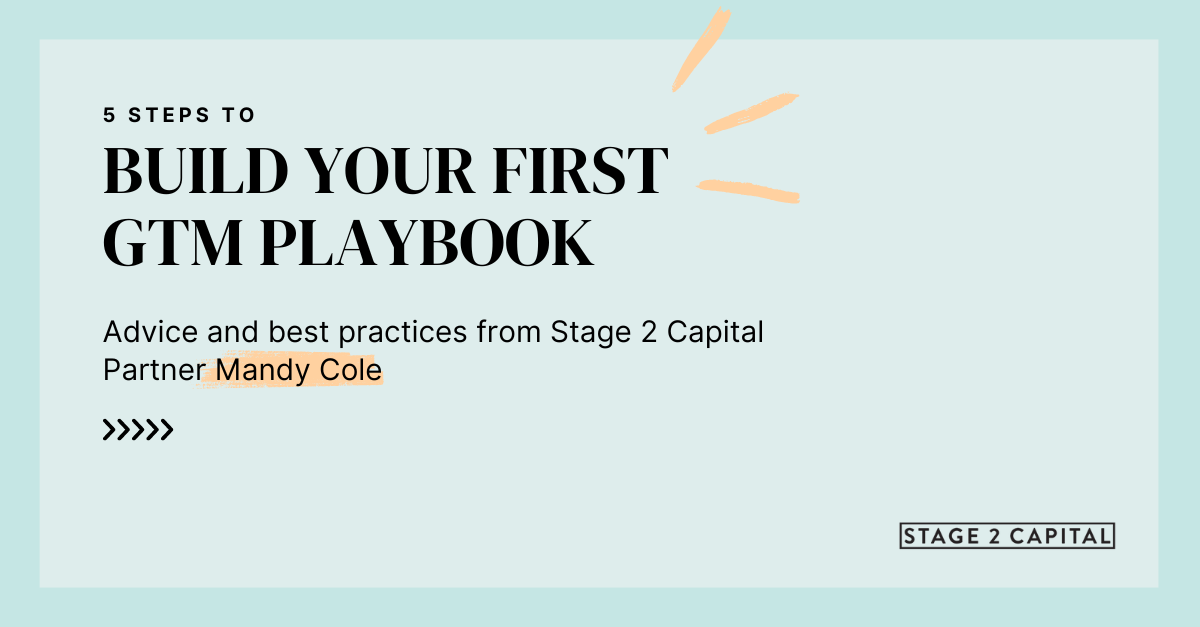
As an early stage founder...
... with your first several customers, demand generation that is ramping, and early signs of strong customer usage, you are probably ready to hire your first sales reps. One of the best things you can do to help them ramp successfully is give them a playbook.
Why?
Not only does it give your team a plan for success, but it also allows you to iterate faster by seeing what’s working and where you need to improve.
Before I share the steps for crafting a playbook yourself, here are some common potholes to avoid:
- Creating a playbook that’s product-focused instead of buyer-focused. When a playbook is focused on the features of the product instead of the value proposition and use cases, salespeople learn to sell features, not solutions. Your Product team should own product documentation, and this playbook should focus on how to sell the product to the customer.
- Designing a playbook that won’t be used. If your playbook is too long, has outdated content, is not user-friendly, or is not validated by top performers, your team likely won’t even pick it up.
- Using a playbook not tailored to your business. Unfortunately, implementing the
exact same playbook that worked at another company likely won’t work for your current company. Be sure to make sure each of these steps are customized for your business. - Not incorporating with your daily operations. If the goal of the playbook is to improve faster by leveraging the data associated with the playbook then you actually have to use it. Make it a part of your process and culture as “your company’s method.”
Now, let's dive into the 5 steps and our GTM playbook template so that you can begin building your own.

Identify your ideal
customer profile (ICP)
As you scale, it is important that you show customer retention and expansion since it’s the biggest signal of product market fit. That means that you want your first team focused on selling to customers that are using, and having success with, your product.
As a founder selling in the early days of a company, it’s common to cast a wider net — this allows you to get feedback on customer pain points, along with use cases of your product. However, once you have several customers onboard and you are bringing on your first reps, you’ll learn faster by keeping those reps focused on the customer profile that is working.
DEFINING YOUR ICP
As you sell more customers and have more data to refine the profile, your ICP will evolve. You can start with something simple based on your first customers that includes:
- MQL Definition Criteria: This is typically criteria you can determine without talking to the customer
- Vertical / Industry — We recommend picking 1-2 verticals that you focus on initially to help your team learn the use cases and ensure that you are aligned with the product.
- Size — The size of companies that are a fit for you typically determined by # of employees or revenue.
- Geography — Where do the customers need to be located?
- Systems / Technology — Think of this as knockout criteria required to integrate with your product. Do they need to be using a certain software
- Sales Qualification Criteria: This is the criteria you want to define for the customer to become a qualified opportunity. There are several methodologies you can use here like MEDDIC, MEDDPIC, etc. We have MEDDIC in our playbook example, but the important thing is to pick one that aligns with your product and be consistent in using it.
- Color-Based Criteria: If it’s helpful, instead of having “inbound” and “outbound” criteria, you can use green, yellow, and red to make it clear what qualifies to move forward and what doesn’t.
- Green is qualified to move forward
- Yellow is for certain circumstances (i.e. inbound only)
- Red means it is not qualified to move forward.
- Use Cases / Case Studies: Use 2-3 of your first customers to create Use Cases
that will help your first reps understand what your product is solving. It’s critical
they understand that BEFORE learning about the features so they can use that
context to help them identify, qualify, and sell to customers.

Define your buyer's
journey
The next step in your playbook is helping your team understand the buyer’s journey so they know the process the buyer will go through to make a decision. One way to introduce this concept is to ask them about the last major purchase they made, and then go through the framework below so they can think through their answers for each of the four stages. Then, you can transition to doing the same thing for your product.
BUYER'S JOURNEY FRAMEWORK
Use our framework to map out the buyer’s journey by answering the following questions:
- Awareness: What are your buyer’s top challenges or pain points?
- Consideration: What other options do they investigate / consider?
- Decision: What is the criteria they will use to evaluate?
- Success: How will they measure success?
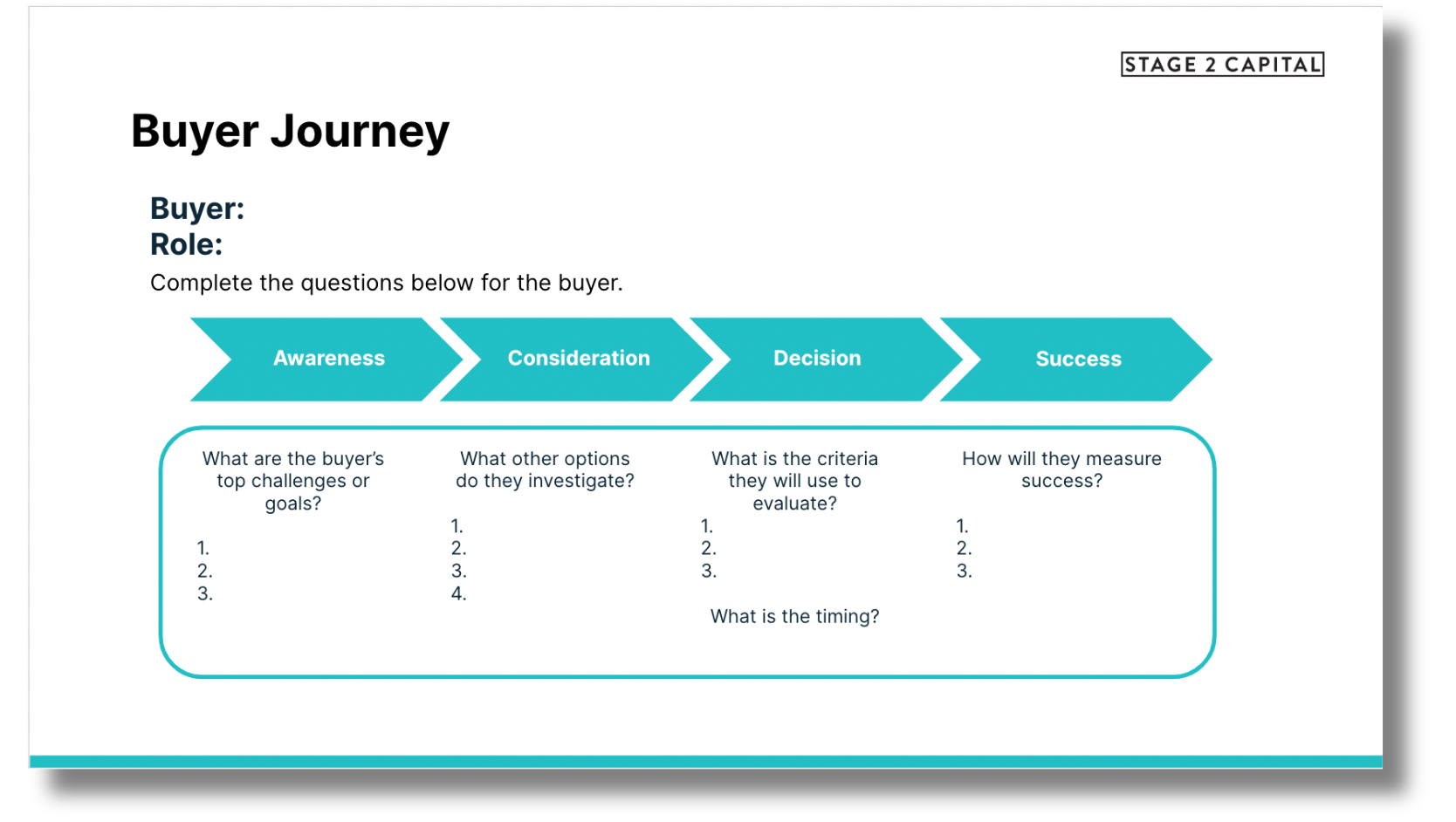
Using the Buyer's Journey template, determine which answers are aligned or misaligned with your product. As you fill in each of the four stages with the answers you hear from your buyer, you may find that a few of them are not aligned with your product or what you are solving. These are important to identify and teach your team how to address them so they can see if they can move forward.
Example: If another option or alternative to your product is something that integrates with software that the customer has, and you do not integrate with that software, you would need to find out if that is critical to the customer to move forward.
Then, you can apply to your learnings to your elevator pitch. Legacy sales teams have elevator pitches that are product-focused and tell the buyer what your product does. Modern sales teams use elevator pitches that are buyer-focused and tell the buyer what your product solves — which ultimately results in a higher connect and conversion rate.
Here’s an example for OpenTable:
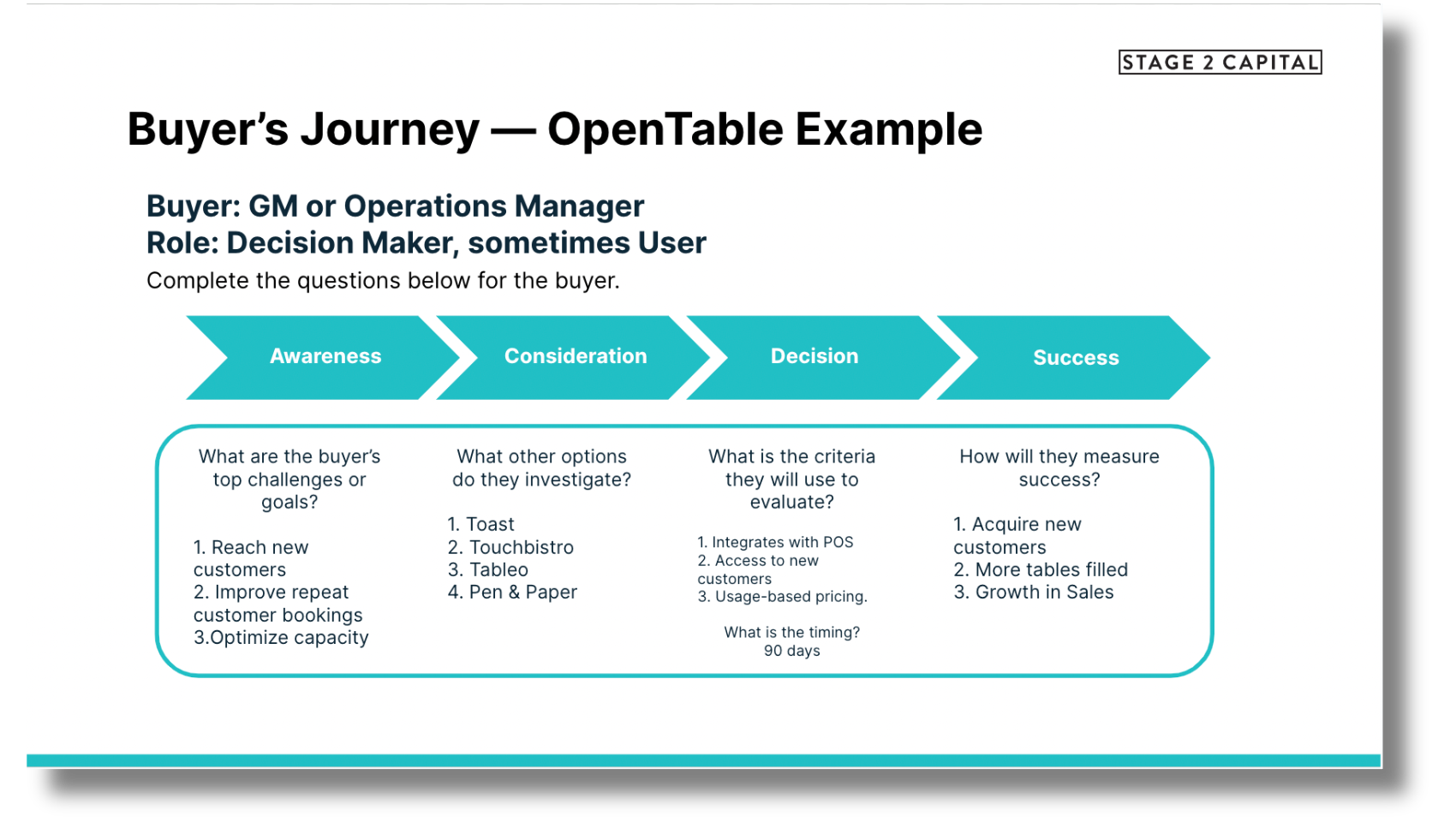

Develop guides to help
your people sell
Learning how to guide the buyer through the stages is the next step in your playbook. We recommend creating four guides that align to the the buyer journey.

Each of these guides should include talking points and examples to help your team navigate that stage.
- Prospecting Guide: Engage the prospect with a completing value proposition and qualify before moving to a discovery call.
- Discovery Guide: Identify challenges you can solve, how you compare to other solutions, how the customer will measure ROI, and clarify the process.
- Presentation Guide: A roadmap to customize the presentation or demo to show how you are solving their challenges, not just a preview of features.
- Customer Success: The steps to successfully onboarding and activating a customer.
Please see our slides in the GTM Playbook Template for each guide that you can customize for your business. We recommend keeping these in a format that is easy to update (Notion, LMS, etc.) and locate.

Align your sales process to the buyer journey
To help your team move a buyer through the process, you want to align your sales process, by stage, to your buyer journey.
Your buyer journey is based on the stages that make sense to a buyer: Awareness, Consideration, Decision, and Success. However, it helps your team to align your internal steps to this journey so they understand what they are doing at each stage.
Example: Your team should understand that prospecting is supporting driving buyer awareness.
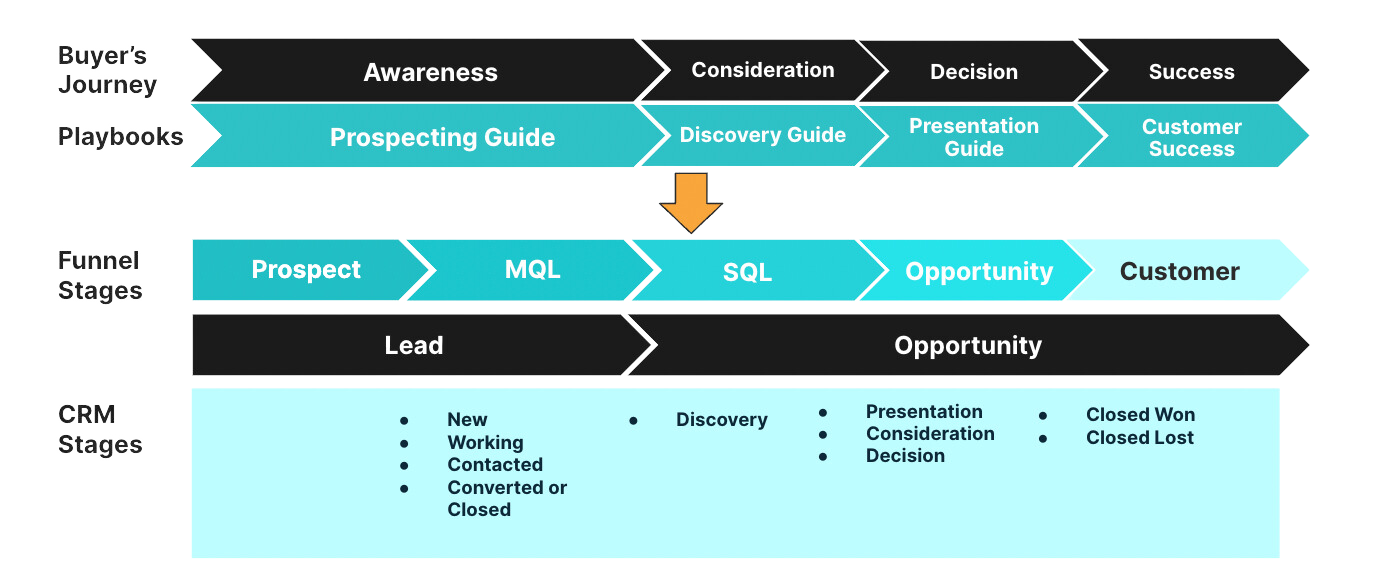
Here’s how you can get started...
- Revise buyer exit criteria for each stage: This should be buyer driven criteria, not sales driven criteria. Why? A buyer’s actions are a better indicator of intent. If a demo call is held, the criteria to move it to proposal stage should be something like:
- “Decision Maker attended demo” — Usually if you are moving to discussing the proposal, the Decision Maker should be involved in the conversation. Sending a proposal to someone to review when the Decision Maker has not been involved usually leads to a stalled opportunity in your pipeline.
- “Buyer accepts/attends proposal review call” instead of “Sent proposal” — Just sending a proposal does not indicate that the buyer is moving forward. How many buyers say, “Sure, send it over, ” as a way to get off the call? You want to remove the fool's gold from your pipeline by using buyer actions, not seller actions.
- Align sales activities to each stage to progress the buyer: Guide your sales team members to do the actions that will facilitate moving the deal forward. These include sending a mutual eval follow-up email, scheduling the next call, or other internal steps like getting pricing approved. You can think of this as a checklist for your Account Executives.
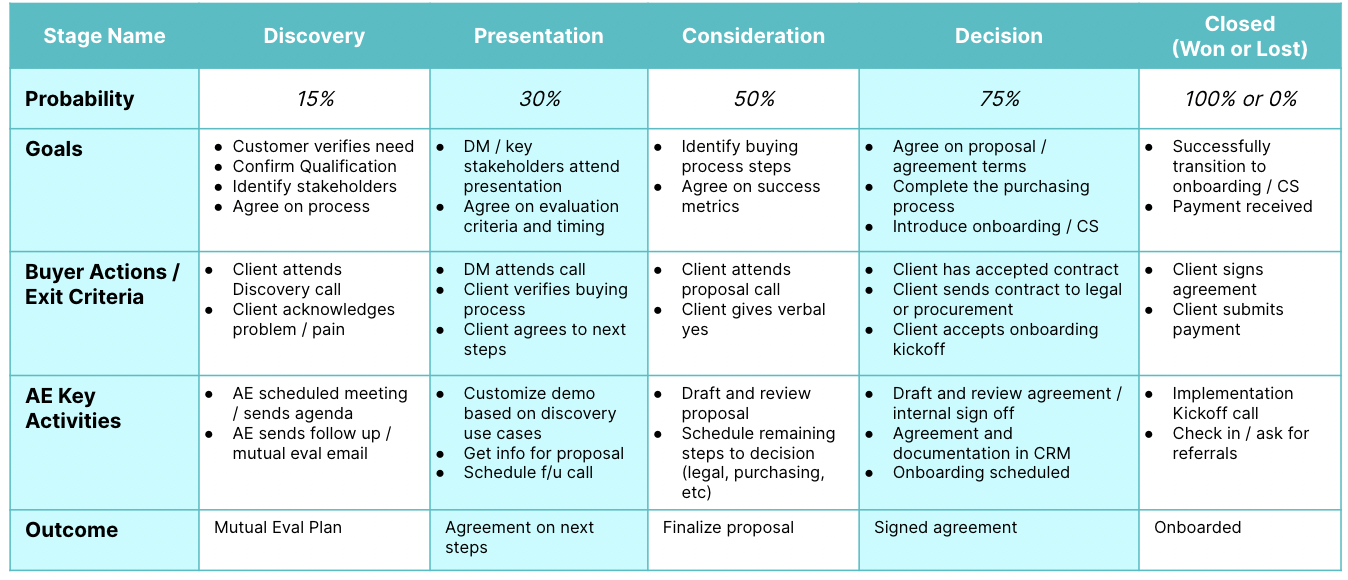
- Customize your CRM to capture criteria: The best way to drive consistency on your team is to build your criteria into your CRM at each stage. This reinforces the importance of using the criteria to both evaluate an opportunity and accurately forecast. Some companies even tie the criteria to the stage so an opportunity cannot move on unless it meets the criteria. Here’s an example of a CRM customized with buyer driven criteria:
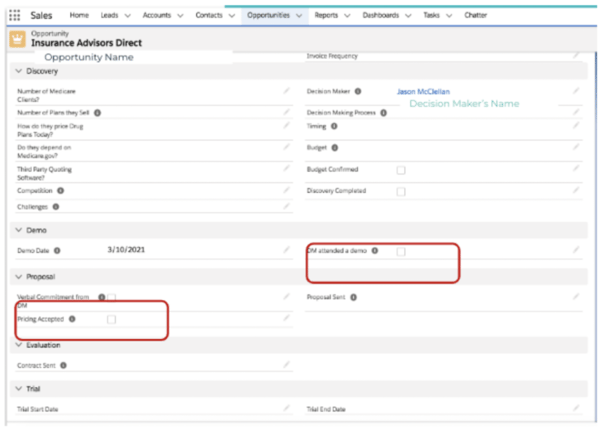

Measure and iterate
A playbook is not useful if it isn’t relevant and actionable. Now that you have a playbook in place, it’s important that you do three things.
- Measure: Use a combination of data and film review to see what is working and where you have opportunity to improve. Data — Track your conversion rate between stages so you can see if there is an area where opportunities are getting “stuck.” Film — Listen to calls or attend live meetings at the stage where your opportunities are getting stuck to determine what may not be working in your playbook. Inspect — Create exception reporting to better understand what isn’t working in your playbook from reps that aren’t using it to steps that are missing.
- Optimize: Using data and film will help you identify where you may need to test a change. Use a subset of your team (or I’ve also seen founders test the change) to make sure you see improved results before incorporating it in your playbook.
- Update: As you iterate, make sure to update your actual playbook so you don’t fall into the “out of date” pothole. An easy way to do this is to schedule time once a month or quarter on your calendar to do playbook updates and keep a list throughout the month of exactly what needs to be done.
As you evolve your team and your playbook, other things you may want to include are:
- Performance expectations of a rep's role
- Competitive battle cards
- Rules of engagement
- CRM dashboards and hygiene
Now that you have the 5 steps to build your playbook, get started by using our GTM Template.
GOOD LUCK AND HAPPY SELLING!

